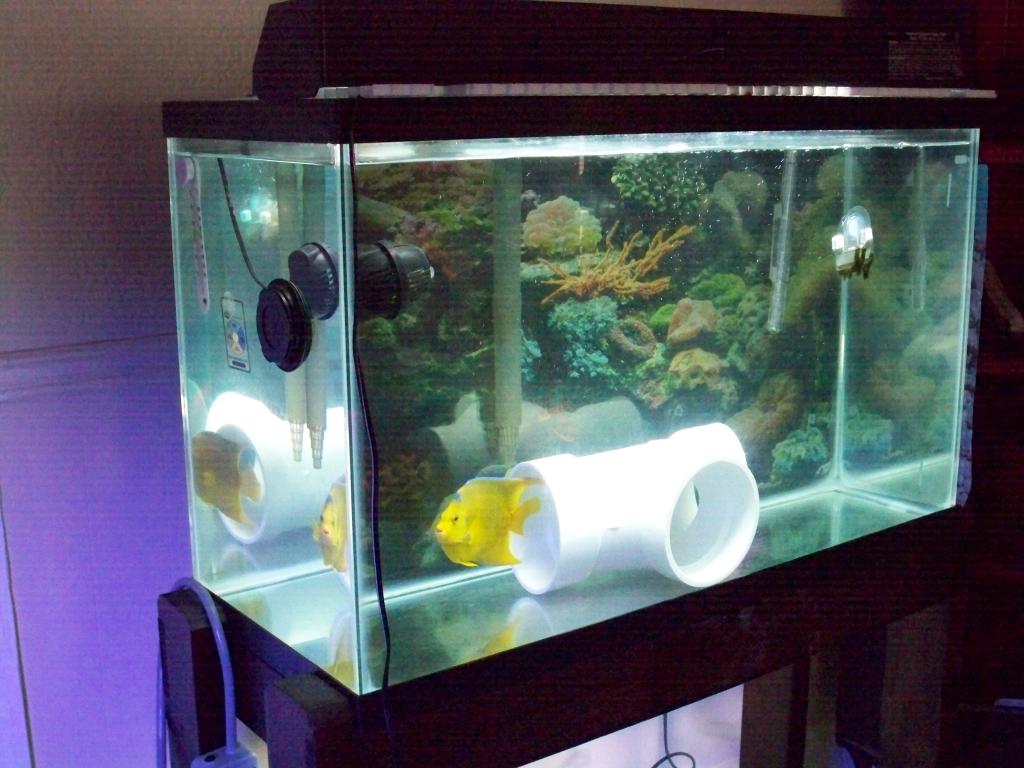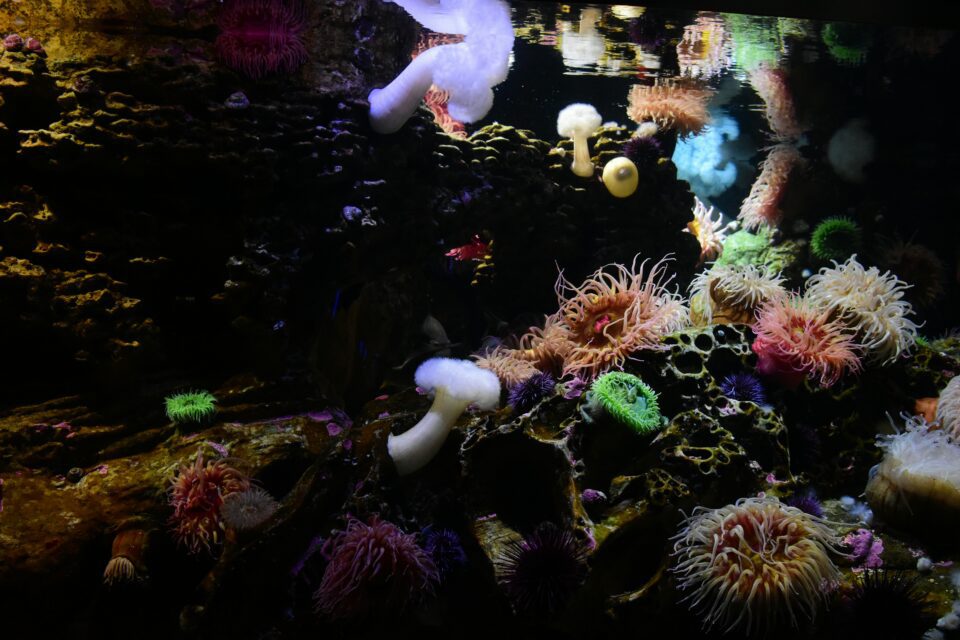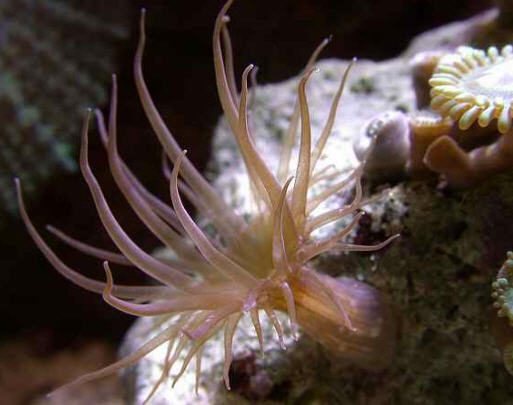How to setup a quarantine system
The following are the essentials:
- Aquarium or container (10-30 gallons seems to work best)
- Heater & thermometer.
- Small wave maker, or air pump + air stone / sponge filter (for circulation & oxygen).
- Saltwater which has been fully dissolved and circulating for at least 24 hours.
- A lid to prevent the fish from jumping out.
- Seachem Ammonia Alert badge.

Recommended additional equipment:
- Hang On Back (HOB) Filter, where “seeded” media with bacteria can be added. AquaClear, Bio-Wheel or Seachem Tidal are all good options. Get one appropriately sized for your tank, or one size up.
- PVC elbows and T’s used as hiding spots for fish to. They are easily cleaned between fish.
Rock/Sand in QT
A small amount of sand is acceptable, but it’s best to avoid using rock in a quarantine tank as it can absorb medications, particularly copper. “Play sand” available at major retailers doesn’t absorb medications and is preferable for fish requiring sand.
You can add one or two small pieces of live rock to help control ammonia in the quarantine tank, provided it comes from a disease-free source. However, once a disease is detected, the live rock should be removed before using medications. Any live rock exposed to a fish disease should be considered “contaminated” and sterilized in a solution of chlorine and water, let the rock dry completely before putting it back in your tank.
Quarantine Tank Lid
It’s crucial to use a lid to prevent fish from leaping out of the tank. You have options , but my egg crate is best due to its affordability, ease of cutting with snips, and the beneficial gas exchange facilitated by its holes. However, in cases where small fish might slip through the holes, it’s advisable to sew screen under the egg crate lid for added protection, or zip tie two pieces of egg crate together overlapping to create smaller holes.
Ammonia Control
Monitoring toxic ammonia in a quarantine tank (QT) is crucial, as it’s caused by fish waste and uneaten food. You can track it using a test kit. Seachem Ammonia Alert badge and Hanna Ammonia Checkers, are the only ones we are aware of that work with copper and with medications. Remember, even tiny amounts of ammonia can be harmful!
If you’re not using a biofilter, regular water changes are the best way to manage ammonia. In emergencies, you can use an ammonia reducer like Prime for 24-48 hours. Caution: Some medications, especially ionic copper like Cupramine, may react negatively with ammonia reducers. However, Prime is safe to use with Copper Power and is a much safer copper overall. Copper power is the only copper we reccomend for this reason.
A biofilter in a QT refers to any porous biomedia that allows water flow and is seeded with live nitrifying bacteria to control ammonia. It can be a simple air-driven sponge filter, glass marbles with water flow, or more advanced options like Seachem Matrix or Fluval Biomax inside a HOB power filter. Note: The Bio-Wheel can also be seeded with bacteria for effective filtration.
How do I “seed” the biomedia? Here are two ways:
- Place it in a high flow area of your DT’s sump (or behind the rocks) for at least 2-3 months before setting up the QT. This timeframe allows ample time for beneficial bacteria to transfer over.
- Introduce a “bacteria in a bottle” product such as Fritz Turbostart, Dr. Tim’s Nitrifying Bacteria, Seachem Stability, or Bio-Spira into the QT at least a week before adding fish.
- Buy live rock from your local fish store (hopefully Artistic Oceans) to have an instant cycle… Just verify any store you’re buying it from has quarantined live rock, meaning they do not keep it with any fish what-so-ever.
Oxygen Exchange
Ensuring adequate oxygen levels in your quarantine tank (QT) is essential, particularly during medication use. You can achieve this by enhancing “gas exchange,” which involves creating surface ripples using a power filter, sponge filter, air stones, or directing a wavemaker upwards. The surface needs ample water movement.
Quarantining Fish
Quarantine Strategies & Protocols
Quarantining fish isn’t an exact science, and different methods have their pros and cons. The most crucial aspect is finding a method that suits your schedule and ensures a high success rate for your fish. While some prefer observational quarantine without medications unless necessary, it’s essential to allocate time for observing key behavioral symptoms of disease.
Pre-QT Dip: After acclimation, consider giving your fish one or two bath treatments before quarantine. We use Methylene Blue and Formalin baths. The product Safety Stop, which we sell, has two premeasured amounts of both and instructions on the dips. We highly recommend going this route as you start off.
The Formalin bath removes all external parasites, like flukes and worms. While the Methylene Blue bath treats ammonia burns, abrasions, infections and detoxifies cyanide exposure. It also has anti-parasitic, antibacterial and anti-fungal properties.
Recommended Quarantine Protocol
After the baths, introduce the fish directly into 2.0 ppm Copper Power. Gradually raise the copper level to 2.2-2.3 ppm (therapeutic) over 24-48 hours using a Hanna copper checker to verify. Copper treats ich & velvet, the most common marine fish parasites.
Once copper is at therapeutic levels, add the following antibiotic for Brooklynella and Uronema:
- Seachem MetroPlex at 2 scoops per 10 gallons.
After 14 or 30 days (explained in copper section), transfer fish to an observation tank or remove copper using Cuprisorb/polyfilter with water changes. Observe a 10-foot radius between tanks for aerosol transmission of ich.
After treatments of copper and Metroplex, deworm with Prazipro, API General Cure, or Fritz Paracleanse if needed. We prefer Prazipro.
After observation, transfer fish to your DT directly if QT & DT parameters match. Adjust your quarantine strategy as needed based on fish health and symptoms.
Other Medications & Treatments
Alternative QT strategies and medications include Chloroquine Phosphate, Fenbendazole for flukes & worms, Freshwater Dip for parasites, Hyposalinity for ich & flukes, and Tank Transfer Method for various parasites.




